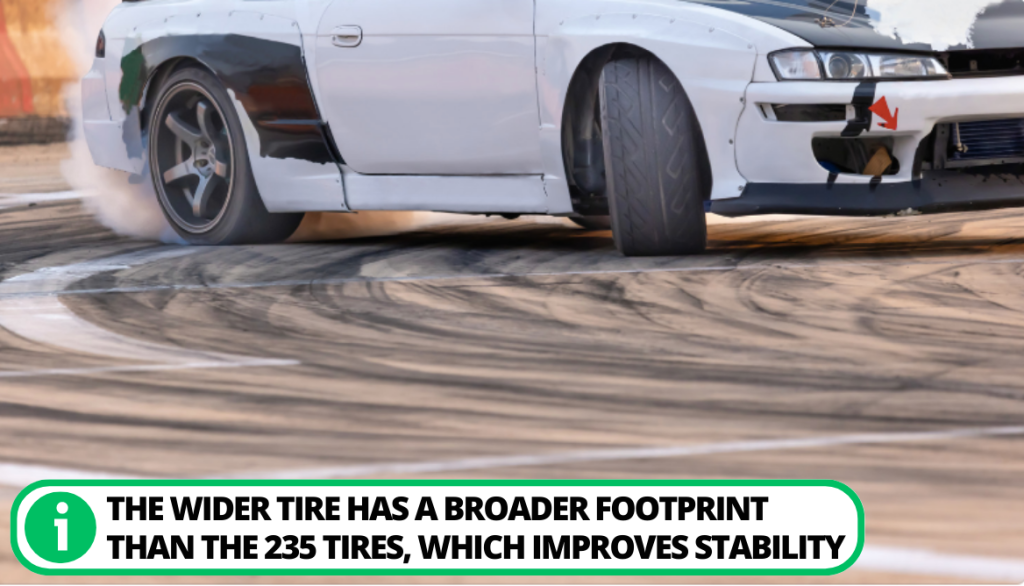235 vs 245 Tires: Detailed Guide Based On 10 Differences
When choosing between 235 vs 245 tires for the vehicles, most people are confused. Determining the right size that aligns with your preferences is challenging, resulting in frequent purchases of the wrong tire size.Hence, we understand the struggle and are here to provide a clear solution.
So, continue reading to learn the positives, negatives, and differences between 235 and 245 tires of the two tires and make a well-informed decision. Let’s get started!
Table of Contents
235 and 245: The Numbers Explained
Both tire sizes differ in terms of their width. 235 and 245 tires, as their names imply, have widths of 235 and 245 millimeters, respectively.

To determine which of these two is ideal for your needs, you must consider factors like tire manufacturers, driving habits, and your car’s specific needs.
Here are some important considerations:
- 235 tires balance maneuverability and traction, whereas its counterpart enhances traction during cornering and acceleration.
- The former tires have a shorter width than 245 car tires, resulting in higher fuel efficiency.
- 245 tire is a bigger tire and gives your vehicle a more sporty look.
- They both are used for medium to large-sized vehicles, including SUVs and mini trucks.
235 vs 245 Tires: A Quick Comparison Between Two Tire Sizes
Let’s look at a quick distinction between the duo:
Quality | 235 Tires | 245 Tires |
Average Weight: | 20-23 pounds | 25-78 pounds |
Rim Diameter: | 15-20 inches | 15-20 inches |
Tread Depth: | 10/32nd to 13/32nd | 10/32nd to 18/32nd |
Tire's Sidewall height: | 4.63 inches | 4.8 inches |
Speed rating: | R, H, or T | R, T, or L |
Loading Capacity: | 1700-3200 pounds | 1700-5000 pounds |
Rolling Resistance: | Lower | Higher |
The Positives and Negatives of 235 vs 245 Tire Size
Now, let’s take a look at the pros and cons of the two tire sizes:
235 Tires
Listed below are the notable advantages and drawbacks:

- Their narrower width makes navigating tight turns and corners easier.
- They offer better fuel efficiency, increasing your gas mileage.
- Provides improved traction in snowy conditions.
- Gives a smoother and more comfortable ride by absorbing road imperfections.
- Produce road noise at higher speeds.
245 Tires
Let’s explore the perks and downsides of these tires:

- These are the bigger tires with a wider footprint that increases stability.
- Provides good traction during high-speed driving and on uneven surfaces.
- They offer better handling and grip on dry roads.
- It can give your vehicle a more sporty look, enhancing its visual appeal.
- The wider tire profile reduces maneuverability in tight turns and narrow spaces.
245 and 235 Tires: A Detailed Look into Characteristics
Regarding tire choices, understanding the characteristics of different sizes is crucial. Therefore, let’s dive in and discover the specifics of 235 and 245 tires.
1. Size
Both tires are commonly used in various vehicles but differ in width.
- In comparison to 235 tires, 245 tires are 10 millimeters wider.
- 235 tires are narrower, resulting in a smaller contact patch with the road.
- The wider tire has a broader footprint than the 235 tires, which improves stability.

Winner: 245 excels in width resulting in better stability.
2. Weight
The 245 weigh slightly more (at least 4-5 pounds) than the 235 tires since they are wider. Let’s explore it in detail.
- 235 tires are lighter because of their narrower design.
- Whereas the bulkier 245 provide a better handling experience on various terrains.
Winner: The 245 emerge victors in this category.
3. Tread Design
The tread design greatly influences the performance and capacities of these tires. It affects handling, traction, and the overall driving experience. Here is a deeper look at the tread pattern:

- Compared to the recently revised 235 tires, the later tire has deeper tread patterns.
- Radial architecture, found in both tires, ensures stability on various surfaces.
- The bigger size of 245 tires gives them a significant footprint for better handling and traction.
- The 245s have distinctive tread designs intended to enhance performance in both on- and off-road driving scenarios.
Understanding the characteristics of the tread designs for these tires can help you make an informed decision when selecting the right tires for your vehicle.
Winner: In this, 245 tires are the winner because of the greater depth in tread patterns.
4. Aspect Ratio
The sidewall height in relation to the tire’s width is indicated by a critical numerical value known as the aspect ratio. It determines the tire’s performance, ride comfort, and handling characteristics. Therefore, choose the one that best fits your needs. Here’s everything you need to know about it:
- The aspect ratio of 235 tires ranges from 45 to 70, whereas 245 tires have an aspect ratio of 40 to 70.
- Smaller tires offer more aspect ratio options than wider tires.
- 235 tires provide a taller sidewall, resulting in a smoother and more comfortable ride.
- Compared to 245 tires, the other tire can have slightly reduced responsiveness and handling.
Winner: The 235 tires take the lead in this category!
5. Performance
Your driving experience depends on the performance of your tires. Therefore, look for the following factors when comparing the performance of these tires:

- While 245 tires offer improved handling, stability, and a crisp steering feel, the other tires have better maneuverability.
- The 245 tires have higher traction on dry terrain, especially for sporty driving, 235 tires perform better in snow and provide a more comfortable ride.
Winner: It’s a tie between them since 235 provides better performance in snow, while 245 on dry surfaces.
6. Rolling resistance
Rolling resistance refers to the force required to keep a tire rolling. It directly affects fuel efficiency, as higher rolling resistance can give better gas mileage. Here’s a quick comparison:
- In comparison to 245 tires, 235 tires have less rolling resistance. They use less energy to maintain motion, which contributes to smoother, more efficient rolling.
- For someone who wants to maximize fuel efficiency without compromising a lot on performance, 235 tires are perfect.
- Whereas 245 tires improved traction and grip at the cost of high rolling resistance.
Winner: 235 tires are the winner because, with lower rolling resistance, they provide better fuel economy.
7. Grip
When comparing the grip of both tires, it’s important to consider the following specific characteristics and capabilities in various driving scenarios.

- 245 tires provide enhanced grip during acceleration and cornering.
- Whereas the 235 exhibits reduced grip compared to its counterpart, especially in high-performance driving scenarios.
Winner: If the grip is your priority, 245 stands tall in the competition.
8. Footprint
The footprint of 235 and 245 tires represent the portion of the tire that comes into contact with the road. It is crucial in determining traction, stability, and overall performance.
- The 235 are narrower tires compared to the 245 tires.
- The wider footprint of 245 tires allows for a more even spread of the vehicle’s weight.
- 245 tires have a slightly flatter contact patch than the 235 tires, leading to more uniform pressure distribution across the surface.
When choosing the footprint, it is important to ensure that the size, either 235 or 245, is compatible with your vehicle’s suspension. Some vehicles have limitations on the maximum tire width they can accommodate.
Winner: 245 tires have a wider footprint which ensures better contact with the road.
9. Noise
Road noise is important when selecting tires, as it directly affects driving comfort. Let’s see how these tires compare:

- The narrower width of 235 tires may contribute to a quieter ride than 245 tires.
- The smaller contact patch of 235 tires with the road surface potentially reduces road noise and tire roar.
- Tread patterns and design choices can further impact noise levels, with some models prioritizing noise reduction.
Winner: With narrower width, 235 produces less noise and stands victor in this category.
10. Segmentation
The segmentation of 235 and 245 tires is based on specific criteria such as performance, intended use, and vehicle type. Let’s look at the segmentation of both tires.
- 235 tires are designed to provide balanced performance for everyday driving conditions, whereas 245 tires give you an edge in handling characteristics.
- 235 tires suit various vehicles, including sedans, hatchbacks, and SUVs.
- 245 tires are better suited for trucks and jeeps.
Winner: It’s a tie between both tires since they are all-season segment offering no compromise at the actual speed.
Are 235 And 245 Tires Interchangeable?
Yes, 235 and 245 tires are interchangeable unless they have the same aspect ratio and are designed to fit the same rim size.
Moreover, 245 tires are 27.65 inches tall, whereas 235 tires are 27 inches. The two tires can be switched out with little adjustment since they don’t have much difference. Here’s an example:
Specification | 235/75R17 | 245/75R17 |
Rim Diameter: | 17 inches | 17 inches |
Aspect Ratio: | 75 | 75 |
Wheel Diameter: | 31.88 | 32.47 |
Circumference: | 100.14 | 101.94 |
Sidewall Height: | 23.91 inches | 24.36 inches |
Our Verdict: Which Tire Width Is Best
Based on the provided information, the best tire for your vehicle is 235 tire. Here’s why:
- They provide less noise due to narrower tire width.
- With small contact patches, they give better fuel consumption.
- 235 tires provide better maneuverability and easier navigation in tight turns and corners.
- The taller sidewalls of 235 tires contribute to a more comfortable and smoother ride, as they have more flex and cushioning to absorb road imperfections.
- 235 tires can often be more budget-friendly compared to bigger tires.
FAQ
Can I fit 245 tires instead of 235?
Yes. Since 245 tires are 10mm larger than 235 tires, adding larger tires will boost your vehicle’s capacity to carry more weight. But for the optimal outcome, you must change all four of them. With this replacement, your car’s grip and handling will improve.
Can I fit 235 tires instead of 255?
No, you cannot directly fit 235 tires instead of 255 tires. The numbers in the tire represent the tire’s width in millimeters, and the 20mm difference between 235 and 255 indicates that the tires have different widths. Moreover, a narrower tire may not properly fit the rim and could impact handling and performance.
Is a 245 tire wide?
Yes, a 245 tire is relatively wide, having 245 mm of width. Compared to narrower tire sizes, these tires offer a wider contact patch with the road surface, potentially providing enhanced stability and grip.
What is a 245 tire equal to?
A 245 tire equals a tire with a width of 245 millimeters.
Conclusion
Choosing between 235 vs 245 tires can be daunting, but understanding their characteristics can help you make an informed decision. The 235 offers improved maneuverability, better fuel efficiency, a comfortable ride, and reduced noise.
Whereas, the 245 emerges as a better choice for grip, handling, and footprint. However, the final decision should be based on individual preferences and specific vehicle requirements.
Among both tires, which one is your favorite and why? Please share your preferred tire size in the comments below!

I`m a current Law Enforcement Officer working within the Counterterrorism Bureau in New York State. I have been Camping for over 20 years. My styles of camping include tent, car, truck, van, and RV travel trailer. I have a YouTube channel where I teach all types of camping with an entertaining method: https://youtube.com/@TheSmallsRVAdventures

![Top 8 Best RV Cabinet Latches [Detailed Reviews]](https://camperlife.co/wp-content/uploads/2021/02/best-rv-cabinet-latches-768x514.jpg)

![Top 7 Best RV Inverters [Buying Guide]](https://camperlife.co/wp-content/uploads/2021/08/best-rv-inverter-768x445.png)
![Top 8 Best RV Stabilizers [Buying Guide]](https://camperlife.co/wp-content/uploads/2021/02/best-rv-stabilizers-768x467.png)
![Top 8 Best RV Battery Monitors [Buying Guide]](https://camperlife.co/wp-content/uploads/2021/02/best-rv-battery-monitor-768x447.jpg)
